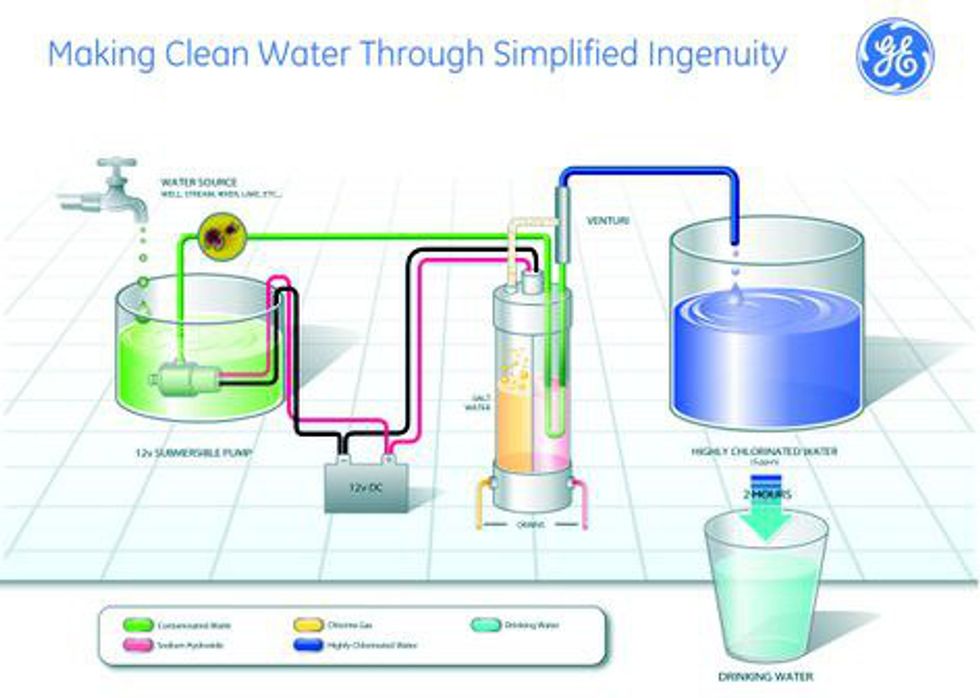Innovation is driven by people's willingness to think outside of the box. It is geared around people's philanthropic mindset in creating a better world for others and the inspiration that others' experiences give to us. Some of these green gadgets are changing the way we think about everyday products, whether it is through the life-changing possibilities they hold, or the value they have to other people.
Solarball
For people in developing countries around the world, access to clean and safe drinking water is almost impossible and is one of the rarest to come across. Monash University graduate Jonathan H. Liow, however, has created a product that could provide clean drinking water to people in developing countries who are unable to find reliable access. This solar-powered ball can produce 3 liters of drinkable water per day through the natural processes. Through evaporation and condensation caused by the sun, this solar-powered ball is able to collect beads of fresh drinking water that can be dispensed by the user.
Sure, Solarball's potential is limited in its size and capacity, but with concepts like this being focused on by millennials, the possibilities for the future of product innovation are much brighter. This step in the right direction could possible mean bigger and better things in the future.
And Jonathan is not the only designer with water-purification in mind. WaterStep, a company who's focus is bringing access to safe water and health education to people in developing countries.
In partnership with GE, WaterStepWaterStep has created a water-purification station that provides safe water to communities throughout the world, preventing potentially harmful diseases that kill thousands of individuals each year. Through their company http://waterstep.org/shoes/donate/Shoes for Water, people are able to donate used shoes in order to help fund the safe water project.
AmazonSmile
In college, time is of the essence, and not all the time do we get to do the things we want to do. As a passionate volunteer, I've realized that college is going to limit my possibilities on how often I can donate my time to helping organizations in my community. As an budgeting college student knows, shopping amazon for college books can be a real money saver, but what if you could make those 'college dollars' mean something? Through Amazon's charitable platform - smile.amazon.com - users are able to shop the same amazon, with the same prices, convient shopping, and wide selections, with 0.05% of the purchase price for their eligible purchases being donated to the charity of their choice.
"The purchase price is the amount paid for the item minus any rebates and excluding shipping & handling, gift-wrapping fees, taxes, or service charges." (via AmazonSmile.com)
http://smile.amazon.comAmazonSmile supports nearly 1 million different charitable organizations including health research programs, local schools and shelters, hospitals, nature conservation programs, and international health awareness organizations bringing clean water and safer living conditions to people around the globe.
Next time you dread buying a $100 book for your english class, or find something you love for a friend or family member, keep in mind that world of possibilities you can give to others!
Reduce, Reuse, Re-Printing
Scientists have calculated that around 5.25 trillion of plastic products are floating around the World’s seas. A huge percentage of these products end up in the digestions systems of mammals and birds. It is estimated that over one million birds and 100,000 marine mammals die each year from plastic debris. The development of 3D-printing, however, has allowed manufacturers to create 3D-printing machines that convert used plastic into bacteria-free, moldable plastic filament.
The Perpetual Plastic Project
The Perpetual Plastic Project aims to turn recycled plastic bottles, cups and other stuff that too often ends up in landfills into 3D printing filament. In the U.S., plastics make up nearly 13 percent of the urban solid waste stream.
Field Ready
Michigan Technological University's first-ever mobile, solar-powered 3D printer can create whole range of printed-products: wind turbines, hand-cranked power generators, medical braces, breast pumps, prosthetic leg covers, water spouts and more. Being done at a fraction of the cost and in light speed, undeveloped nations with unreliable access to electricity are given endless possibilities for growth. In Haiti, the nonprofit organization Field Ready is working on printing umbilical cord clamps in less than eight minutes.
Ekocycle
Will.i.am and The Coca-Cola Company have joined efforts to launch EKOCYCLE™ to inspire new things made from recycled materials. Their shared ambition is to motivate brands and people around the world to promote sustainable living. Their overall goal is to help consumers recognize that items they consider waste today may be a part of a lifestyle product they can use tomorrow. This concept of creating everyday objects from previous household waste allows the company to show how one man's trash can still have value to someone else. With partnerships with companies such as Keds, Terracotta, Globe-Trotter, Angela Scott, and Tern Bicycles, Ekocycle is able to produce recycle-made shoes, bicycles, suits, and much more!
Pembient
http://signup.pembient.comPembient's bioengineered wildlife products are created to man-made rhino horns that are identical in texture and shape. These synthetic horns are believed by co-founders, Matthew Markus and George Bonaci, to be the next essential step to saving the Black Rhino species that is on the brink of extinction. These man-made copies are not only identical in their visual makeup, but actually have rhino DNA that has been added to the powdered makeup of the design. Including several metals and minerals, these fake horns could potential lower the value of rhino horns on the black market, influencing poachers to sell these almost identical substitute and saving the rhino species from extinction.
In more ways than one, 3D-printing has allowed for growth within the product design industry. Whether it is helping to protect wildlife, influence recycling efforts, or spread disease awareness and prevention to countries around the world, the product design industry is seeing limitless possibilities with the continuing increase in 3D-technology.





















